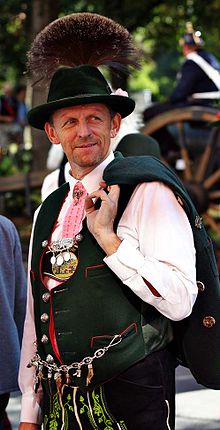Gilet
The gilet ( French for "vest") is a sleeveless outer garment for men, which is common under this name in old Bavaria , Switzerland and Austria .
In the 17th and 18th centuries the gilet was worn as a vest under the Justaucorps . It was often made of precious fabrics and richly decorated with embroidery on the front . The back of the gilet was not embroidered because the Justaucorps was worn over it.
In the beginning, the gilet was knee-length, that is, as long as the Justaucorps, and had sleeves, which however disappeared over time. Most of the many buttons and buttonholes were purely decorative (“blind”), as only the middle ones were closed. Later the gilet became shorter. In the end it barely reached above the waist and gaped wide at the bottom.
In Switzerland , the vest is also commonly referred to as a gilet . This term is also common in Austria , whereas the term vest has a different meaning. In general, every vest is called a gilet in old Bavaria , whereas the term vest is more a cardigan.
Some Bavarian costumes , such as the Miesbach costume , also have a gilet. In contrast to the knitted vest , the front of the gilet is made of green felt , while the back is made of black fabric. The red hem is also typical .
